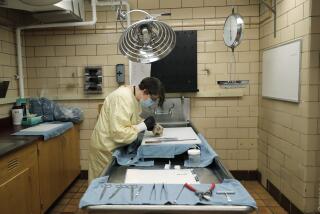UCLA Scientists Find That Viruses Can Meld Into a New, Lethal Form
- Share via
Scientists at UCLA have shown for the first time that two non-lethal strains of a virus can combine their genetic material inside an infected host to produce a virus that is lethal.
The implication of this work, according to Dr. Jack G. Stevens, chairman of microbiology at UCLA Medical School, is that it suggests a second way that “new” viruses arise in nature. Until now, it has been generally assumed that mutation is the way this occurs. During the mutation process, the genetic material of a virus undergoes a spontaneous change that results in an organism with new characteristics.
In a telephone interview, Stevens said it is conceivable that the highly lethal AIDS virus, known as HIV, arose as from the recombination of two benign strains of the virus.
“I’m not saying that is what happened, but I am saying that based on our work it is possible,” the researcher said.
Stevens, R. T. Javier and Dr. Farhad Sedarati used two mild strains of the herpes simplex Type 1 virus (HSV-1) in laboratory mice to demonstrate that, under proper conditions, the two strains can combine their genetic material to produce a virus capable of killing the mice. HSV-1 causes cold sores in humans.
It was already known that this kind of recombination of genetic material could be made to occur in a test tube. But, according to the researchers, “to our knowledge, this is the first evidence that during a mixed infection, two avirulent (non-disease-causing) viruses can interact in an animal to produce disease.”
In a report in the Nov. 7 issue of the journal Science, they describe using the viruses in two experiments with 26 mice. When an equal mixture of the two viruses was injected into the rear footpads of mice, 62% died. None of the mice died when inoculated in the same way with either virus alone.
An examination of the mice revealed that the two strains had recombined--probably in the foot--and traveled along nerves to the brain, killing the animals. Studies of the viruses revealed that they shared genetic material from each of the two strains.
Stevens said that while recombination historically could have accounted for the appearance of a dangerous virus, it is highly unlikely that any individual could be infected by two strains in this way to produce a deadly virus.
Stevens has long been an authority on the herpes simplex virus. Thirteen years ago he reported animal experiments showing that HSV-1 uses nerves as its pathway when traveling from the lips, where it causes cold sores, to an inner recess near the brain where it lies in a latent state before eventually returning to the lips when stimulated by sunlight or some other force.
Scientists have speculated that the hibernating virus near the brain may on rare occasions invade the brain itself and cause neurological disease. Or, in its travels from near the brain, the virus might take another branch of the nerve and end up in the eye, instead of the lips, where it may cause an infection of the cornea.






